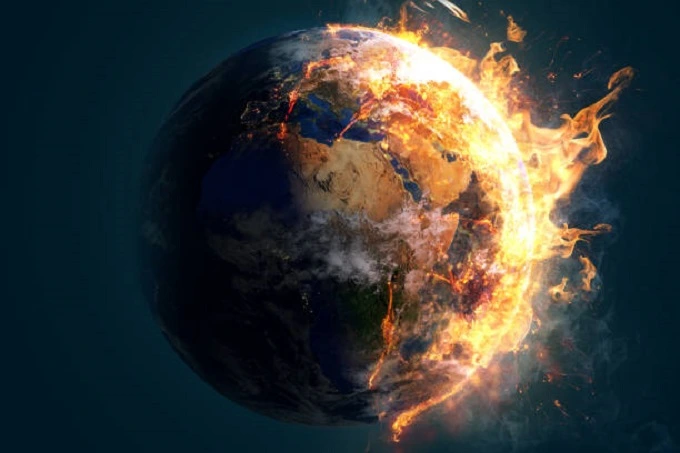Disasters that should happen in the future according to science

We have discussions from time to time about disasters that occurred a very long time ago and those that we have not yet been fortunate enough to experience. But all of this occurred either a very long time ago or is merely a matter of wild speculation.
On the other hand, scientists predict that disasters with a high degree of accuracy will occur within the next 50 to 100 years. Put another way, they are expected to occur within the not too distant future. As a result, we will keep you updated on the latest global disasters.
1. A massive earthquake is going to be caused by the San Andreas fault
No, it’s not about the fact that all physical copies of Grand Theft Auto: San Andreas will suddenly burst and cause the building to collapse; instead, it’s about another San Andreas, which is a transform fault that runs between the Pacific and North American plates and is almost 1,300 kilometres long. This fault traverses the territory occupied by the state of California as it travels along the western coast of the United States. The situation is made worse because two more fault lines, the San Gabriel and the San Jacinto fault lines, run parallel to the San Andreas fault.
2 major earthquakes have already hit this region. An earthquake that struck San Francisco in 1906 and had a magnitude of 7.7 points was responsible for the deaths of three thousand people and the destruction of up to 80 percent of the entire city. The tremors from the earthquake could even be felt on the continent’s interior. Another major earthquake struck in 1989, resulting in the deaths of 62 people and the destruction of 18,000 homes. Scientists believe that in the not-too-distant future, roughly within the next 30 years, an earthquake with a magnitude of 8.0 or higher is likely to occur. If this occurs, it could result in the deaths of tens or even hundreds of thousands of people and cause the redrawing of the map of at least the state of California. In addition, an earthquake in this region may lead to the reawakening of nearby volcanoes and may trigger a chain reaction of additional earthquakes.
2. A mighty earthquake will result in the destruction of Istanbul and the areas surrounding it
The city now known as Istanbul was formerly known as Constantinople and served as the capital of Byzantium. Istanbul’s location is very advantageous from a strategic standpoint, as it blocks off the Bosphorus Strait. And everything would be fine, but Istanbul is constantly under the threat of a powerful earthquake that could potentially destroy the city and the areas surrounding it. The problem is that the Turkish capital is situated only 20 kilometres away from the North Anatolian Fault, which serves as the boundary between the Eurasian and Anatolian tectonic plates. This one also exists in a manner comparable to that of the San Andreas fault in California, which is also responsible for significant earthquakes.
Scientists were able to foresee the disaster that befell the city of Izmit in 1999, which resulted in the deaths of seventeen thousand people, by analyzing the stresses that occurred along the fault. They believe that an earthquake will happen soon further west along the fault, possibly somewhere in the vicinity of Istanbul. If this is the case, then the disaster will be much more severe than in the case of Izmit. This is because, in addition to the direct destruction caused by the aftershocks, there is a possibility of a huge tsunami occurring, which will wash away the remains of the Turkish capital and the surrounding area within a radius of several kilometres into the sea. If this happens, then the disaster will be much more severe.
3. Global forest fires may consume a large part of the planet by 2050
Take, for instance, the United States of America, which, compared to Russia’s vast territory and relatively few forest cover areas, has a significantly greater number of fire-fighting resources at its disposal. It has been estimated by experts from this country that the total area that forest fires in the United States have consumed has increased by a factor of three since the year 1999. And this upward trend continues as a result of the fact that each succeeding year becomes more and more arid and windy due to climate change and deforestation, which once protected vast territories from the invasion of air masses.
The fires that occurred in Australia in 2019-2020 and others like them in Russia have proved that the areas affected by fires are continuously expanding. If this trend continues, scientists predict that by the year 2050, forest fire seasons will be three weeks longer than they are at present and will produce twice as much foul-smelling smoke as they do today. To put out fires of this magnitude requires the combined efforts of many nations’ armed forces and a significant financial investment.
4. A new, more severe pandemic may soon arise
We have stated that if antibiotics are used without any form of regulation, miserable circumstances will emerge in conjunction with the already concerning rate at which urbanization is increasing. When the mortality rate is 0.81 people per 1000 population, despite only 6.8 percent of the entire Earth being covered, the coronavirus pandemic demonstrated that humanity is not ready even for such challenges.
People who laugh at Bill Gates and other famous personalities for voicing their opinion that a new pandemic that is more violent will sweep the planet in the next 20-30 years simply do not understand the context of what they are saying. Scientists are in agreement with this assessment and say that if nothing changes, the financing of the healthcare sector does not grow, and humanity continues to take antibiotics and other medicines without control, then by the year 2050, there may only be a few tens of millions of people left on the planet as a result of the global extinction caused by more contagious and deadly infections caused by either well-adapting viruses or superbugs.
5. Due to climate change, cities and islands like Amsterdam and Venice, as well as others, will be immersed
People didn’t give much thought to the possibility that cities like Amsterdam and Venice could become submerged in water when constructed those cities. As you may not have thought, the very same Amsterdam, located six meters below sea level, was routinely flooded from the very foundation. To prevent this, they started building dams hundreds of years ago. But the people who lived in the past did not anticipate that the glaciers would start to melt, which would lead to an increase in the level of the oceans around the world.
What exactly is the disaster that will occur here, given that the waters will not rush in all at once, as they did in the same cities in California and Istanbul, and that the process will take many years? This will result in a global humanitarian disaster, which will cause millions of people to be forced to relocate to more remote parts of the continents. And at this point, we are not only talking about Amsterdam and Venice but also about other cities like New York, as well as about islands like the Maldives, which, according to the predictions of scientists, will be submerged in water within the next half-century if nothing is done to change the current state of affairs.




